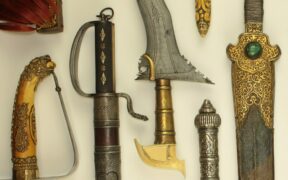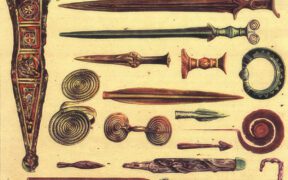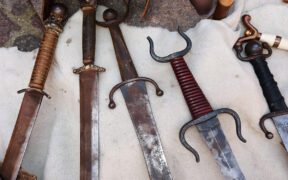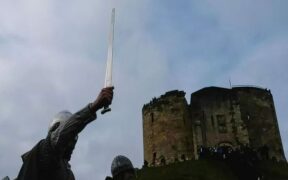Our content features commercial links to our products, committed to transparent, unbiased, and informed editorial recommendations. Learn More
Viking Swords: From Battlefields to Your Collection – Discover the Legend
NO AI USED This Article has been written and edited by our team with no help of the AI
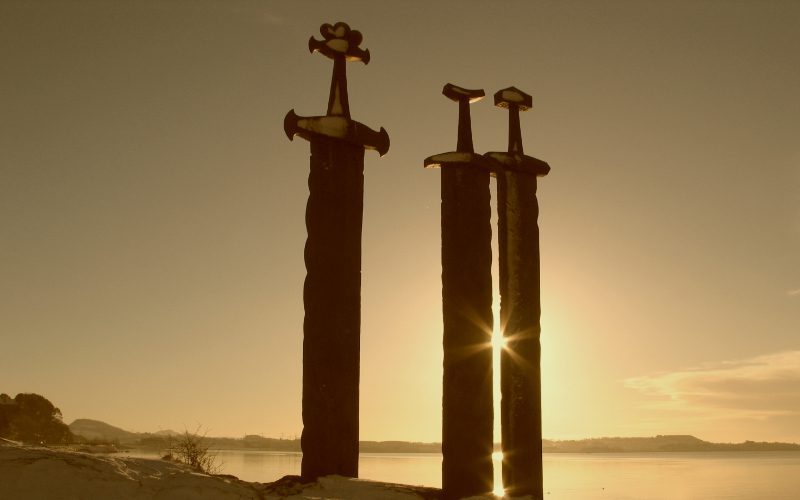
From the 9th to the 11th century, the Vikings raided and took control of areas of Europe and beyond. The Viking swords, including the Ulfberht
Characteristics of the Viking Sword s
Early swordsmiths created visually distinctive
Here are the unique characteristics of the Viking
Metal and Construction
Viking swords often had pattern-welded blades, produced out of several pieces of metal rather than a single piece. Early smiths twisted individual iron bars, hammered them together to create a core, and then added a cutting edge. Depending on how a swordsmith combined different pieces of metal, he could produce varying decorative patterns, usually enhanced through polishing and oiling.
Many thought that the ancient pattern-welding technique produced blades of superior quality due to the different alloys that provided the combination of flexibility and hardness. However, it actually created weaker
The Vikings also used the high-quality Ulfberht swords made of crucible steel, which likely originated from Central Asia. It was known as wootz steel and later as Damascus steel. These blades were durable and coveted due to their exceptional hardness and a watered appearance. Today, most replicas feature high carbon steel blades.
Blade Appearance
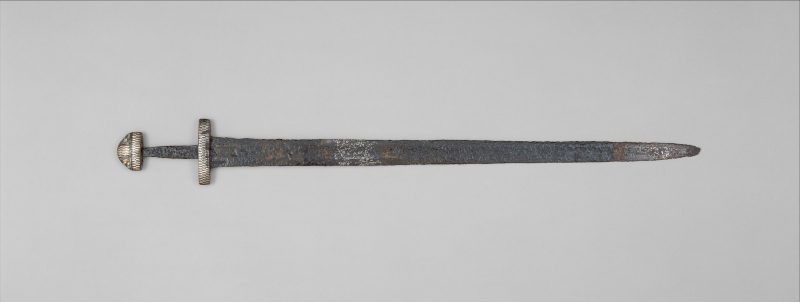
Most Viking swords had a straight, double-edged blade with a rounded tip, suggesting that the warriors preferred slashing attacks. In the earlier part of the Viking Age, single-edged swords were more common in Norway than in other parts of Scandinavia.
Still, late Viking swords were more tapered than earlier ones. Some historical types of swords also featured a fuller running along the blade to make the
The so-called Ulfberht swords had the inscription +VLFBERH+T, in which the final letter T stands separated at the end of the word. Many believe it was a religious invocation rather than a maker’s signature. However, inferior copies and contemporary forgeries usually have slight differences in spelling of the name.
Length and Weight
The overall length of a Viking
Sword Mounting
The Viking
Sword Hilt
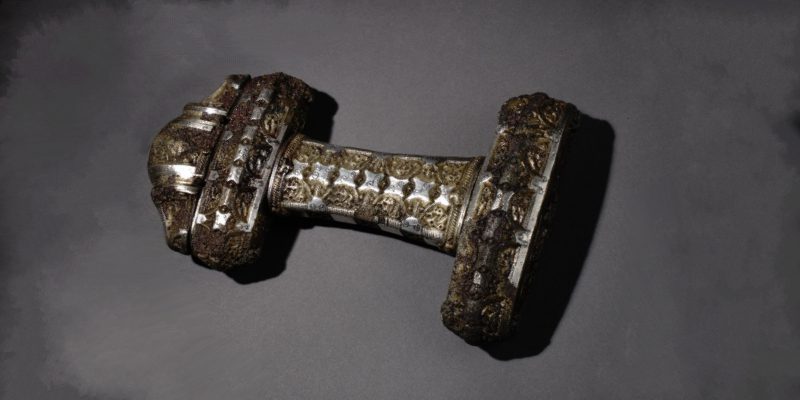
While most Viking swords had iron hilts, some had bone, walrus ivory, and antler hilts. A Viking chieftain traditionally owned finely crafted swords to use in ceremonies. Most Viking swords had straight guards and lobed pommels, usually made from copper and decorated with inlaid geometric designs in silver and brass.
Viking swords served as heirlooms passed from generation to generation, so some historical swords have blades older than the hilt. Caution is needed when buying modern Viking swords, as some mass-produced items have inaccurate finishing of hilt fittings. Other manufacturers also base their swords on film and television props rather than genuine Viking weapons, yet sold as replicas.
Scabbard
Scabbards were multilayered with lining, wood, inner and outer coverings. The lining was often a cloth or sheepskin to protect the blade. Outside the lining, there was a layer of wood, as well as layers of textiles and leather. There were also metal chapes to protect the ends of the scabbard. It suggests that the scabbard was often as expensive as the
Facts About the Viking Sword
The word Viking comes from the Old Norse víkingr, meaning pirate or raider. The whole population may not be raiders or warriors, but any free man in the Viking Age had the right to carry weapons. Here are the things you need to know about the Vikings and their
The Vikings originated in Scandinavia.
Scandinavia is in northern Europe, the area that became modern-day Norway, Sweden, and Denmark. Often traveling by sea, the Vikings plundered the coasts of Europe during the 9th to 11th century, earning them the name “pirate” in early Scandinavian languages. Today, the term “Nordic” may refer not only to Scandinavia but also to Finland and Iceland.
The Viking warriors were called many different names.
The name Viking first appeared in Anglo-Saxon sources, but some cultures called them by different names. In England, they were called Danes or heathens. In France, they were also referred to as Danes, as well as Norsemen. In Russia and Byzantium, they were known as Varangians or Rus.
Most Vikings carried weapons at all times.
The swords were the most expensive Viking weapon due to the iron material, so many carried axes, spears, fighting knives, and bow-and-arrows. Contrary to popular belief, Viking helmets had no horns, as this would be impractical in battles. Like Viking swords, helmets likely served as similar status symbols.
The pattern-welding technique created visually distinctive
A swordsmith could create variations in the blade design by twisting the iron bars in different ways along the length of the blade. The herringbone pattern was the most common, but others were more complex. However, the smiths used the technique only on long, narrow-bladed weapons, including knives and spears—never on axes.
The Viking swords were primarily slashing weapons.
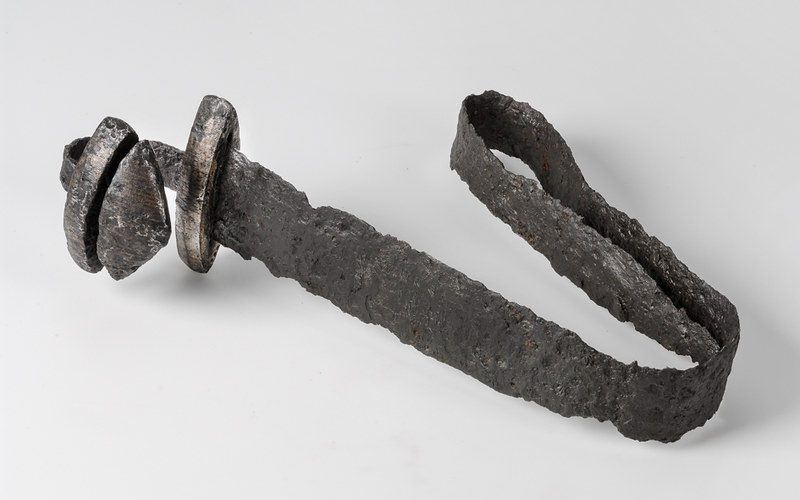
The Viking
The warriors swore loyalty to a Viking chieftain over the
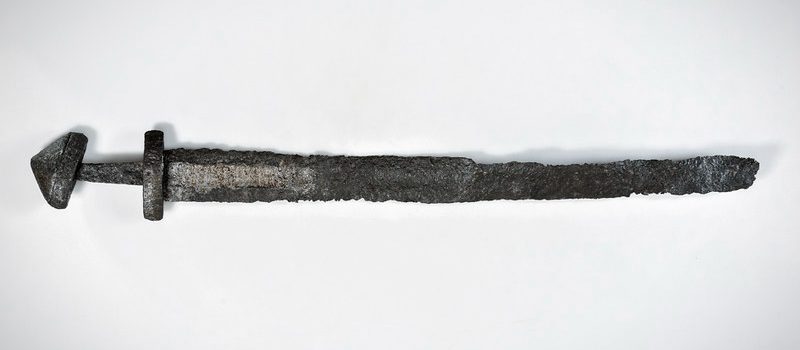
The Viking chieftain traditionally held his
The Viking swords served as status symbols.
In Viking society, free men had the right to carry weapons, yet not everyone had the means to acquire a
Some swords have names in the sagas.
The Old Norse literature mentions several kennings for the
The Vikings also used a fighting knife called seax.
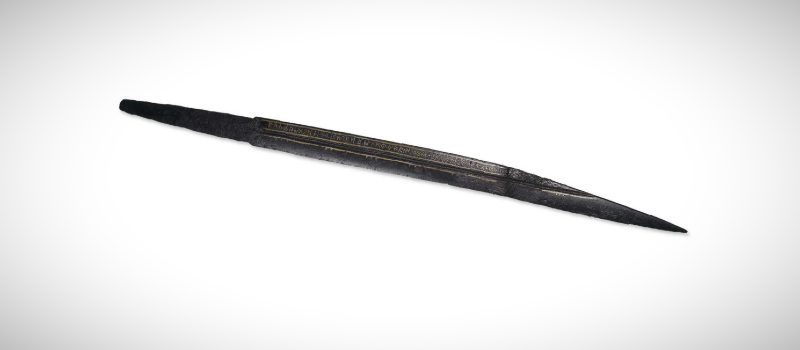
Sometimes spelled sax, the Viking seax is a fighting knife, often large enough to be considered a short
Archeologist Jan Petersen established a typology of Viking swords based on hilt designs.
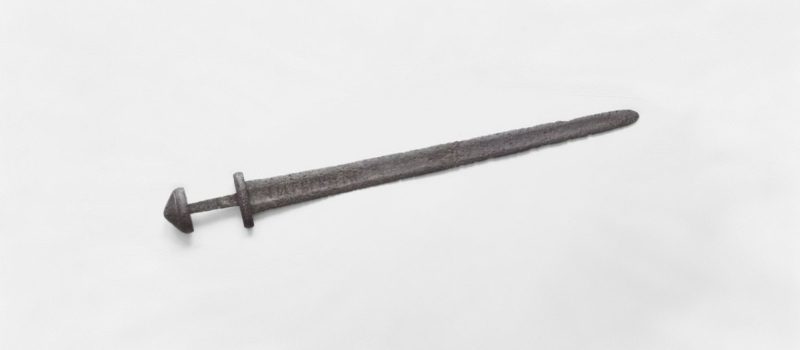
In his book The Norwegian Viking
Historian Alfred Geibig also created an alternative classification system of swords based on the hilt and blade. Unfortunately, it seems unsuitable for swords in museum collections, as blades and handles were often combined to create a single
Uncovering the Mystery of the Ulfberht Swords
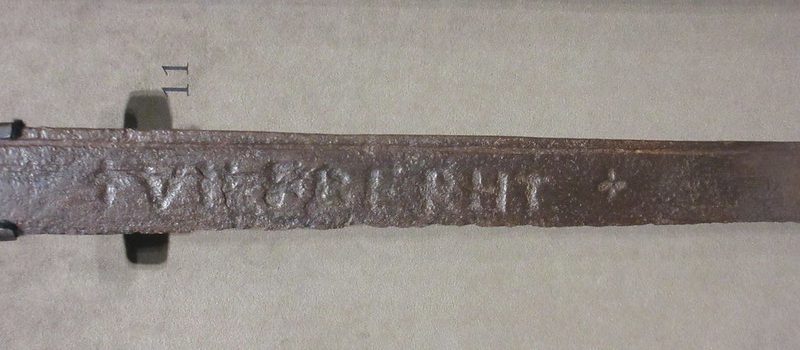
Many believe the inscription +VLFBERH+T on some Viking swords was a mark of a maker or of a workshop. However, many claim it was a religious invocation to wish the owner good fortune. Let’s uncover the mystery and the meaning behind the Ulfberht swords:
Some Ulfberht swords were of crucible steel.
The technology of manufacturing steel in a crucible likely originated in India and spread throughout Central Asia. From 819 to 999 CE, the Samanid dynasty controlled all crucible steel production sites in Central Asia. During the time, there was also an extensive trade of crucible steel ingots from Central Asia to Scandinavia.
The Ulfberht swords can be associated with Haakon the Good of Norway.
Reigned from 933 to 960, King Haakon I Adalsteinsfostre was one of the most respected Scandinavian rulers. He would have had the power and wealth to support an extensive trade between the Persian dynasty and Scandinavia. So, he likely commissioned these sword blades during the first half of the 10th century.
The Ulfberht swords feature a Carolingian script.
In 10th-century Norway, paganism and using runes were still the tradition. By the mid-11th century, the Vikings gave these traditions up in favor of Christianity and writing. However, 10th-century England was already using Carolingian script. Interestingly, King Haakon the Good was brought up in England and only returned to Norway to rule, associating him with the Carolingian script on the Ulfberht swords.
The characters on the inscription begins with a cross “+.”
The time period coincided with the introduction of Christianity to Norway. In Germanic tribes, runic inscriptions on swords endowed them with spiritual properties. Many believe that the crosses in the
Sword blades found in burials and rivers were associated with early religious rituals.
Many Ulfberht
The inscription +VLFBERH+T may have had multiple meanings.
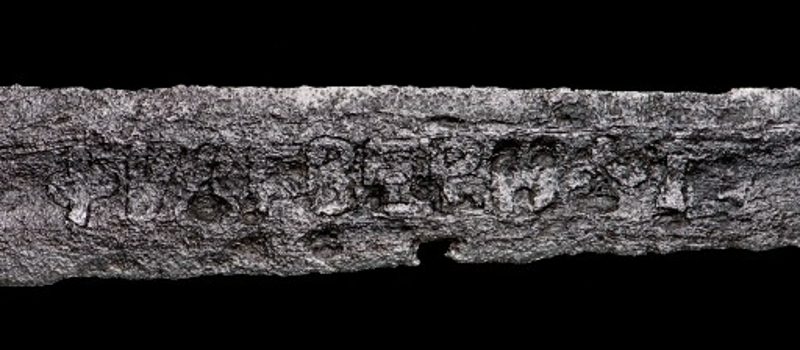
The Ulfberht swords had an inscription, which reads as ulvefødet or ulvebåren, meaning born of a wolf. In some interpretations, the word ulv, meaning wolf, may imply greed or age and death. It may also be associated with the Latin prefix ult- that means the boundary or the end. On the other hand, the Old German bertha translates as bright, shining. So, the
However, it could also be a mix of pagan and Christian symbolism. In Norse mythology, wolves also accompanied Odin into battle. The inscription could be associated with the pagan god, as well as the Christian god. In the Heimskringla, a collection of sagas of the early Norwegian kings, Haakon was baptized and brought up as a Catholic. So, he could have used the inscription to his advantage.
History of the Viking Sword
The Viking
Development of the Viking Sword
After the fall of the Western Roman Empire, the cavalry
In the 9th century, early Viking swords had straight, single-edged blades, found mainly in Norway. By the 10th century, double-edged swords became common. Some of them may have been produced in Scandinavia, particularly from Hedeby, the Viking’s largest trading town. Founded by Danish King Godfred in 808, it became the center of trade between Scandinavia and the rest of Europe. It now lies in the south of Denmark’s modern border with Germany.
The Viking Sword in Duels
The Vikings utilized their swords as dueling weapons. There were two types of duel: holm-going or holmgang and trial by combat or einvigi. The former had strict rules, and the consequence for the loser was not necessarily death, but the latter had looser rules where fighters fought to the death.
In Viking times, a casual remark, word of abuse, and slander could easily lead to a challenge to duel. Unlike the late medieval dueling in Europe, the combatants had to go through a series of rituals, so there was a religious aspect to the contest.
The Viking Sword in Modern Times
The Vikings remind us of ancient heroes, violent conquests, and military glory. It is not surprising that Viking swords remain popular in stage combat, martial arts, and films.
In Historical Reenactment
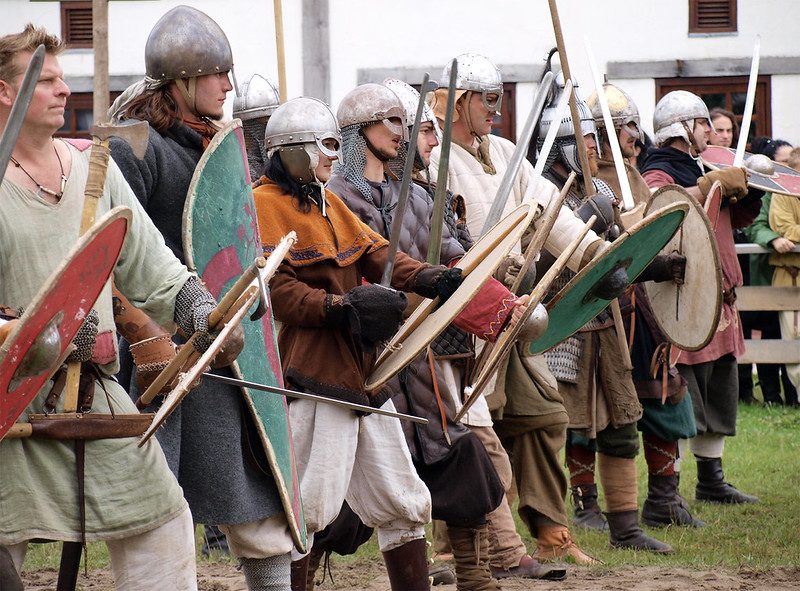
Several performances today portray Viking combat, using swords and other weapons. Re-enactors often represent well-armed warriors, wearing chain mail armor, iron helmets, and leather cuirasses. Today, it is possible to obtain good modern Viking swords, usually with blunted blades for stage combat.
However, reenactments are confined to safety and have strict off-target areas, from the head to the lower arm and lower leg. In reality, these would have been the targets in the Viking Age. While a historical reenactment can be enjoyable for the combatants and audience, it can never replicate Viking combat.
In Martial Arts
The Historical European Martial Arts or HEMA recreates historical fighting techniques from different periods. It allows more realistic handling of weapons than reenactment, as practitioners often follow the historical fighting manuals. Most practices involve medieval swords and Renaissance weapons.
However, there are no surviving manuals from the Viking Age. As a result, many explore how a Viking would traditionally use his
In Film and Television
The Vikings remain a popular theme for television dramas, such as the Game of Thrones and The Last Kingdom, which sparked interest in Viking swords and warfare. Unfortunately, there are also several misrepresentations of Viking weapons, including the hand-and-a-half sword, which was only introduced long after the Viking Age.
Conclusion
Swords were among the most prized weapons of a Viking warrior, from dueling to conquering territories. Some of them were given names in Icelandic sagas, while others had inscriptions imbued with spiritual properties. Today, Viking swords remain relevant in martial arts, historical reenactments, and films.
